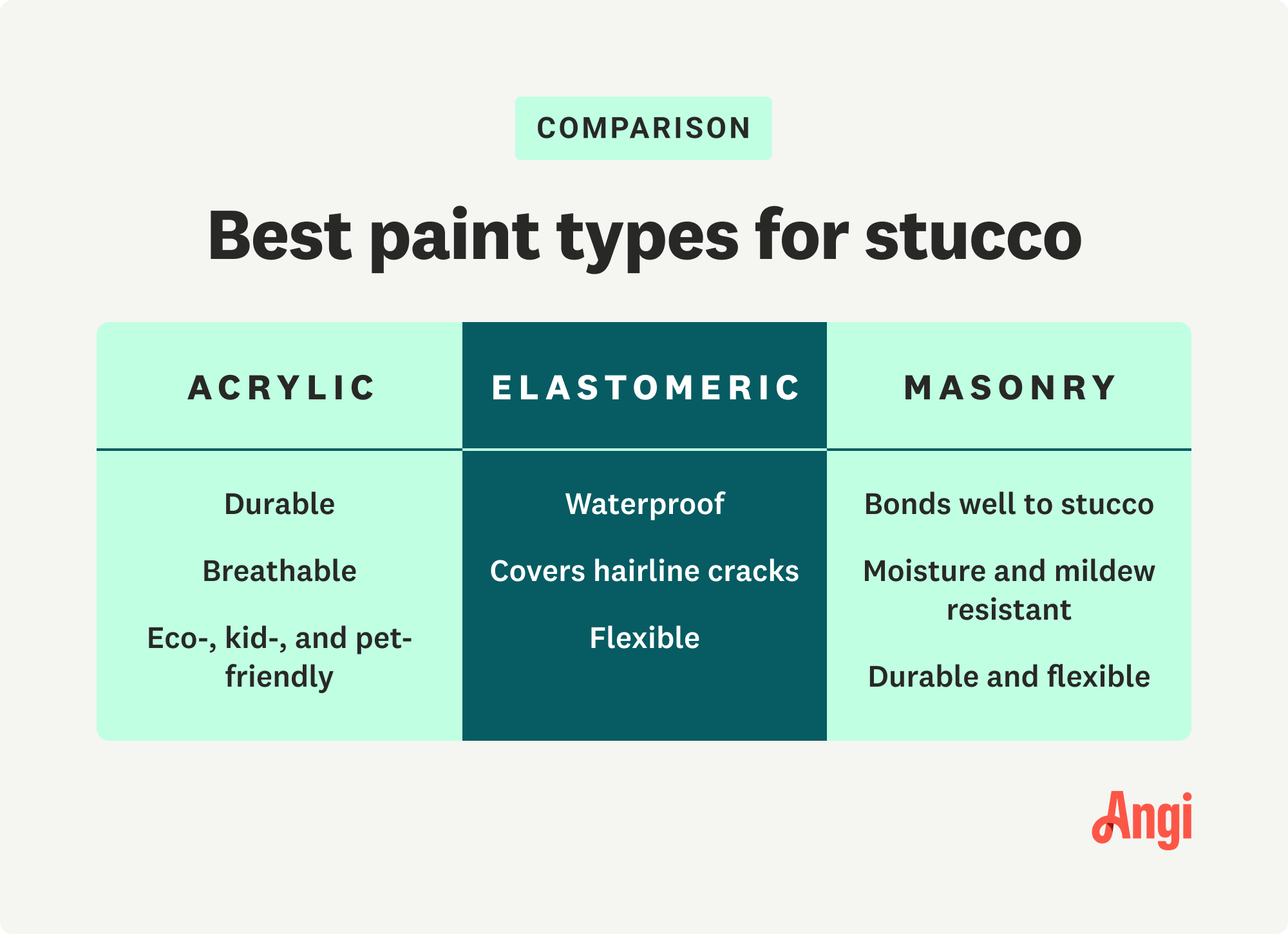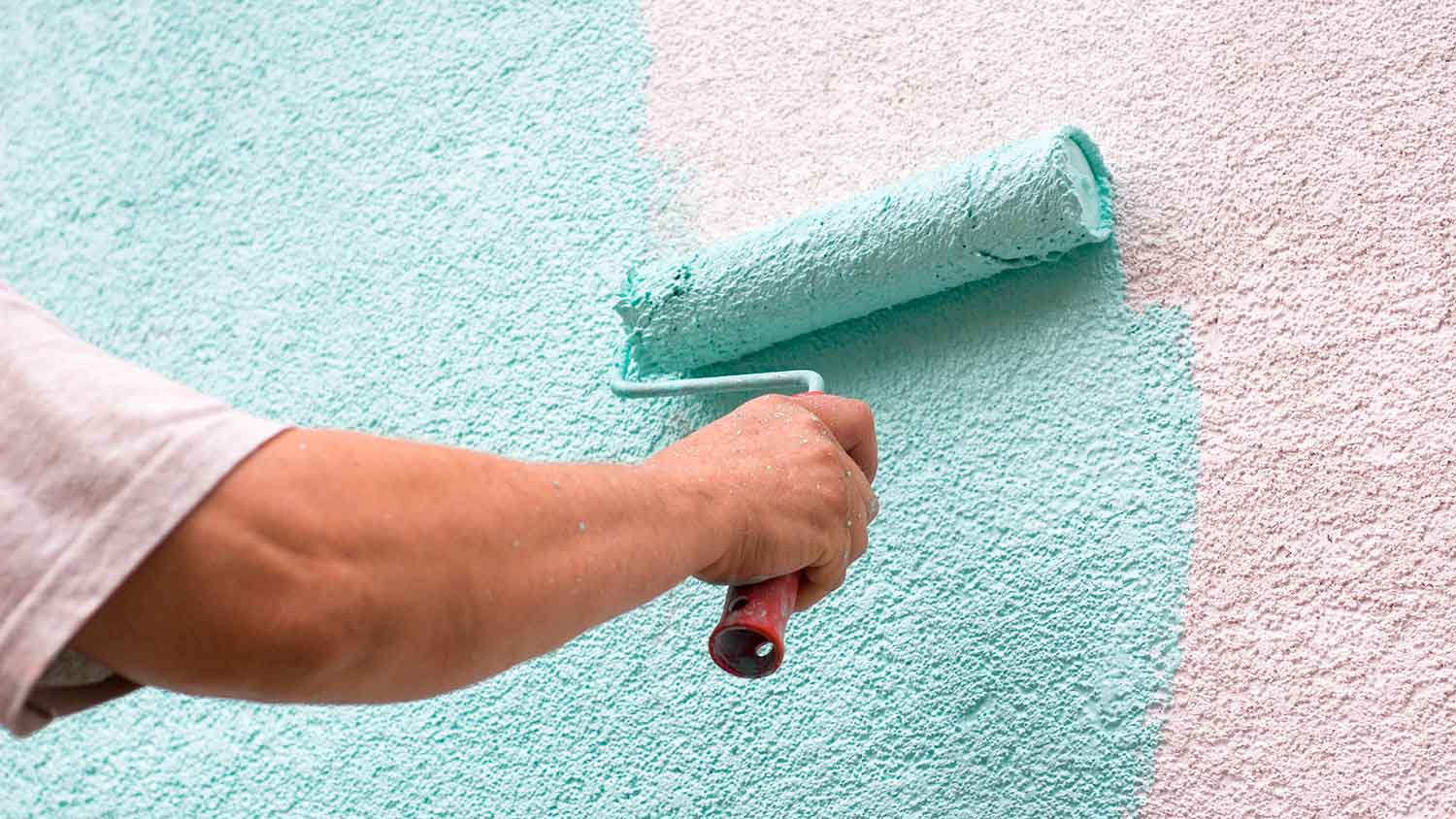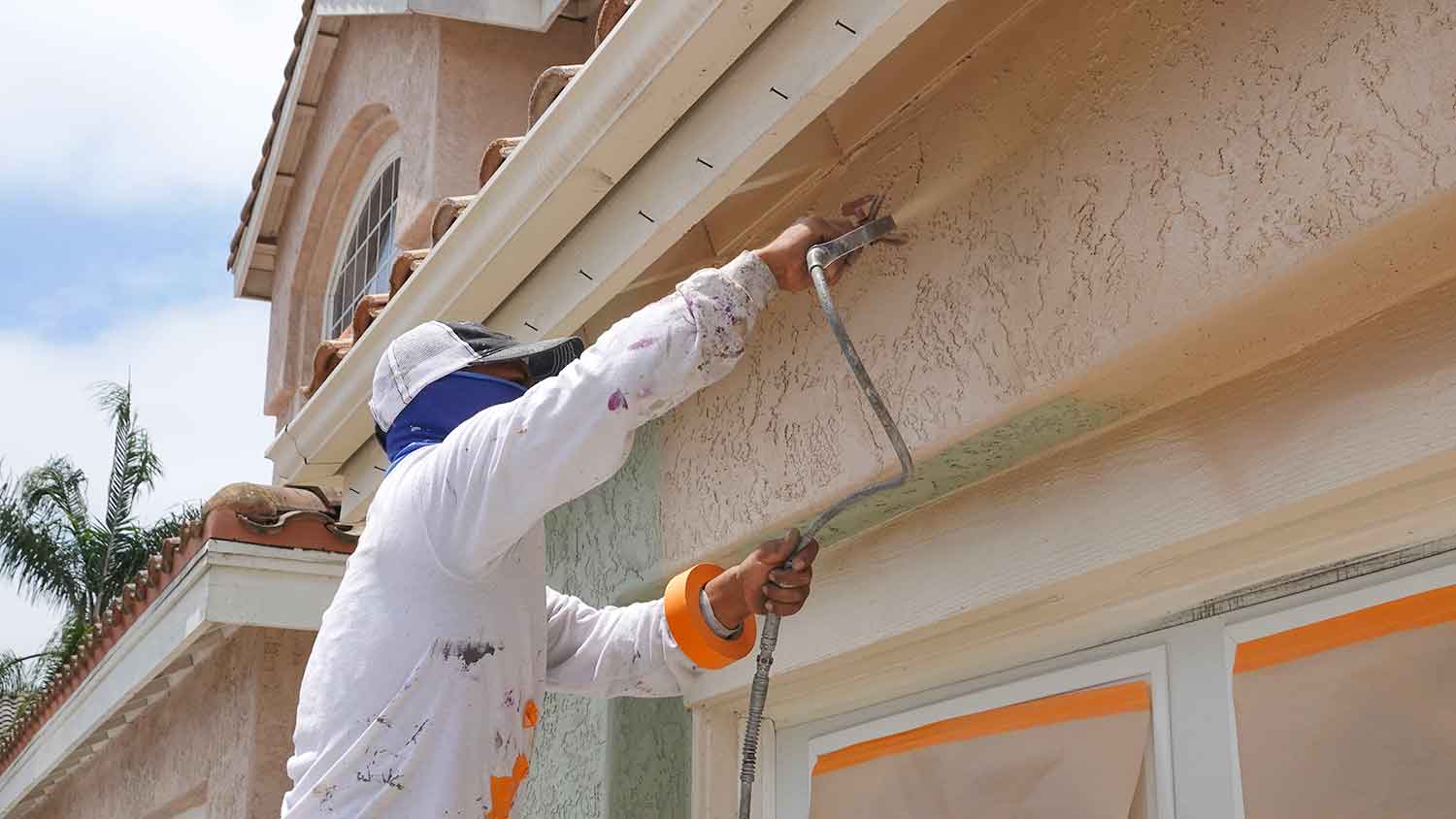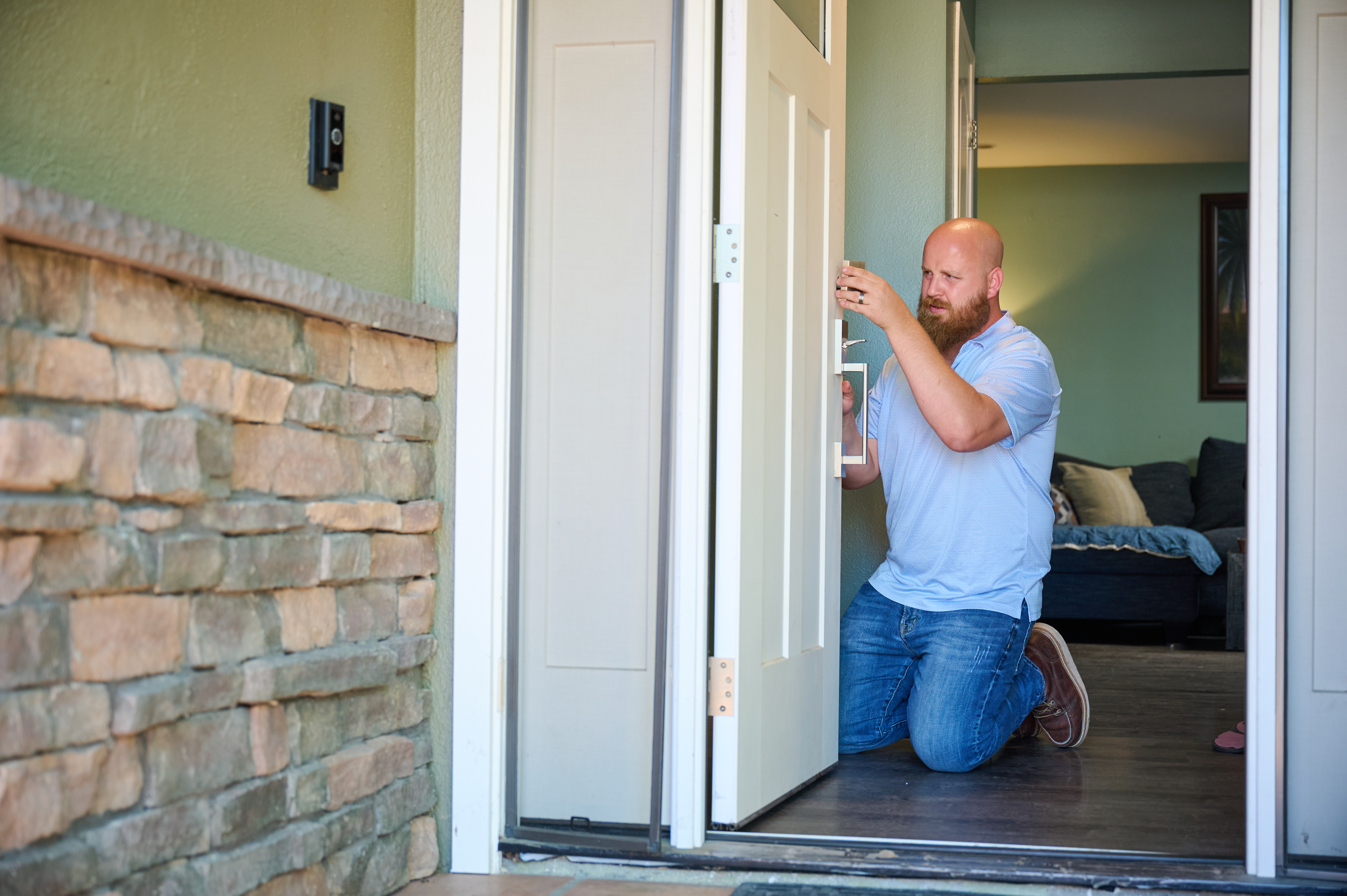
Do you want the color of your exterior doors to really pop? Learn about the labor cost to paint the front door, back door, and other entranceways.
Choosing the right paint can significantly extend the life span of your stucco


Painting stucco requires careful prep and the right products to avoid cracks, peeling, and trapped moisture. A professional painter can ensure long-lasting results.
Expect to pay $3,600–$7,200, or up to $8,500 with elastomeric paint, which offers superior sealing but requires expert application.
Painting stucco is more complex than standard siding. Improper prep or application can lead to peeling, mold, or water damage. Elastomeric paint especially requires pro application due to its thickness and cure time.
Acrylic paint is affordable and easy to apply, but it offers less water resistance and may not adhere as well as other options.
Elastomeric works well in rainy or humid areas, especially where minor cracks are already present.
Masonry paint is a solid choice for anyone prioritizing durability and mildew resistance in damp environments.
Stucco lends a beautiful texture to the outside of your home—as long as you maintain it correctly. Paint your stucco every five to 10 years using the right paint to keep your home protected against the elements while looking great at the same time.
Whether you’re in one of the hotter regions of the U.S., like the Southwest, or in an area that gets colder and has a proper winter, you need a paint that meets your needs and budget. Let's look at a few of the best paints for stucco.


In settings that don’t get a lot of rainfall, 100% acrylic latex paint is the best paint for stucco because it checks the boxes mentioned above: It’s durable, breathable, and flexible. Acrylic paint is one of the easiest paints to work with, and it dries quickly—the downside is that you might not have time to go back to fix mistakes, but you can just paint over them.
If you’re concerned about the cost to paint a stucco house, then acrylic tends to be the most affordable option, costing $20 to $50 per gallon on average. Acrylic latex paint is also widely available at any home improvement store.
Durable
Breathable
Flexible
Widely available
Easy to work with
Relatively affordable
Wide range of colors
Eco-, kid-, and pet-friendly
Can last five to 10 years on properly prepared stucco surfaces
Dries very quickly
Doesn’t adhere to stucco as well as elastomeric or masonry paint
Not as waterproof as elastomeric paint

As the name suggests, elastomeric paint has elastic, flexible properties. Elastomeric paint is applied as a liquid and dries into a rubber coating on your stucco. It’s probably no surprise that elastomeric paint’s rubbery quality makes it a great choice as a waterproofing paint. Still, it takes much longer to dry than other paints—about 72 hours—and it’s not exceptionally breathable. Elastomeric paint costs $35 to $50 per gallon on average.
Water-resistant
Can fill and cover hairline cracks in stucco
May last up to seven years longer than acrylic when applied to properly prepared stucco surfaces
Limited color selection
Can take up to 72 hours to completely cure
Not very breathable and can trap moisture in the stucco
Lack of breathability can lead to mold and mildew problems as well as deterioration in freeze/thaw cycles
Can be more costly than acrylic paints
More labor-intensive to apply and should be done by a professional painter
Can only repaint with another coat of elastomeric paint
When applied over multiple layers of paint, the weight can cause older paint to delaminate

Masonry paints are formulated to adhere well to surfaces like concrete, brick, cement blocks, and stucco. Its strengths include high durability and resistance to moisture and mildew. You can find masonry paints at most home improvement stores. However, the color selection is limited.
Masonry paint is a good choice if you can find the color you want because it combines the best qualities of acrylic paint and elastomeric paint. The cost also lands between acrylic and elastomeric. Masonry paint costs $25 to $50 per gallon.
Durable yet flexible
Bonds strongly to stucco
High moisture and mildew resistance
Relatively easy to find
Limited color selection
The same quantity covers less area than acrylic paints
Although stucco doesn’t need paint on top of its finish coat, topping stucco siding or veneer with two coats of paint is a best practice, just like with aluminum or vinyl siding. The best type of paint for stucco is durable and adheres well.
It also needs to interact appropriately with moisture, being waterproof from the outside but allowing vapors to escape from the inside without blistering or peeling. And, of course, the paint you use on your stucco home should be as low maintenance as possible.
Acknowledging the intricacies and expertise required to paint stucco's rough and uneven surface compared to other siding materials is essential when deciding to DIY or hire a pro.
The coarse and porous nature of stucco can cause paint to adhere or absorb unevenly, resulting in an unsightly finish. Also, damaged stucco surfaces must be addressed before painting, requiring meticulous preparation.
If you're contemplating a DIY endeavor, conduct thorough research to understand the complexities involved fully.
For optimal results and to safeguard your investment, it's advisable to seek the services of a skilled professional exterior painter. Their experience and specialized tools can prevent potential damage, deliver high-quality work, and save you time and money.
The typical cost to paint a stucco house falls between $3,600 and $7,200, with an average national cost of $4,500.
The primary factors influencing this cost are the size of your home and the type of paint you choose for the project. For example, elastomeric paint, the gold standard for stucco known for its remarkable resilience and 10-year lifespan, can drive your total expenditure up to $8,500 for a 2,000-square-foot home.
Lastly, remember that damaged stucco will require repairs before painting, adding to your out-of-pocket costs.
Josh Maday contributed to this piece.
From average costs to expert advice, get all the answers you need to get your job done.

Do you want the color of your exterior doors to really pop? Learn about the labor cost to paint the front door, back door, and other entranceways.

Looking to give your fence a refresh? This guide explores the cost to stain a fence—and the cost to paint it, too— so you can budget for your project.

The cost to paint a house's exterior depends on its size, siding type, and height. The finish and the home's exterior condition also play a role.

Painting your front door involves proper preparation, primer, and several coats of paint. Here's everything you need to know about how to paint a front door.

Front door colors for a brown house include green, brown, white, and more. Keep reading to find the perfect shade of paint for your exterior door.

The best time to stain a deck is when it’s dry but not too sunny. How often you restain a deck depends on climate and wood type, but every two to three years is normal.